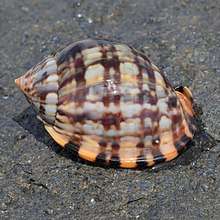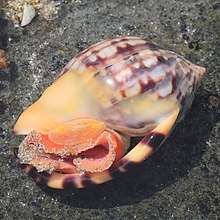Semicassis labiata
Semicassis labiata (formerly also known as Phalium labiatum) is a species of large predatory sea snail, a marine gastropod mollusc. This species is in the subfamily Cassinae, the "helmet shells" and "bonnet shells", which feed on sea urchins.[2]
| Semicassis labiata | |
|---|---|
 | |
| Semicassis labiata (Lamarck, 1822) | |
 | |
| underside of living specimen | |
| Scientific classification | |
| Kingdom: | |
| Phylum: | |
| Class: | |
| (unranked): | |
| Superfamily: | |
| Family: | |
| Subfamily: | |
| Genus: | |
| Species: | S. labiata |
| Binomial name | |
| Semicassis labiata (Perry, 1811) | |
| Synonyms[1] | |
| |
Subspecies
Semicassis labiata zeylanica (Lamarck, 1822) shell
Semicassis labiata iredalei (Bayer, 1935) shell
Distribution
This species occurs in New Zealand[3]
Habitat
The minimum recorded depth of Semicassis labiata iheringi is 25 m, and the maximum recorded depth is 84 m.[4]
gollark: Horrible privacy issues, probably, but it is very cool.
gollark: Which can in fact see through walls.
gollark: There's some interesting work going on with WiFi sensing.
gollark: Which can totally get data which doesn't actually exist in the image.
gollark: With AI.
References
- WoRMS (2010). Semicassis labiata. In: Bouchet, P.; Gofas, S.; Rosenberg, G. (2010) World Marine Mollusca database. Accessed through: World Register of Marine Species at http://www.marinespecies.org/aphia.php?p=taxdetails&id=533621 on 2011-02-17
- Gofas, S. (2012). Semicassis labiata (Perry, 1811). Accessed through: World Register of Marine Species at http://www.marinespecies.org/aphia.php?p=taxdetails&id=533621 on 2012-07-15
- Powell A. W. B. (1979). William Collins Publishers Ltd, Auckland ISBN 0-00-216906-1.
- Welch J. J. (2010). "The "Island Rule" and Deep-Sea Gastropods: Re-Examining the Evidence". PLoS ONE 5(1): e8776. doi:10.1371/journal.pone.0008776.
- Finlay, H. J. (1928). The Recent Mollusca of the Chatham Islands. Transactions of the New Zealand Institute. 59: 232-286.
- Dautzenberg, Ph. (1929). Mollusques testacés marins de Madagascar. Faune des Colonies Francaises, Tome III
- MacDonald & Co (1979). The MacDonald Encyclopedia of Shells. MacDonald & Co. London & Sydney.
- Spencer, H.G., Marshall, B.A. & Willan, R.C. (2009). Checklist of New Zealand living Mollusca. Pp 196-219. in: Gordon, D.P. (ed.) New Zealand inventory of biodiversity. Volume one. Kingdom Animalia: Radiata, Lophotrochozoa, Deuterostomia. Canterbury University Press, Christchurch
This article is issued from Wikipedia. The text is licensed under Creative Commons - Attribution - Sharealike. Additional terms may apply for the media files.